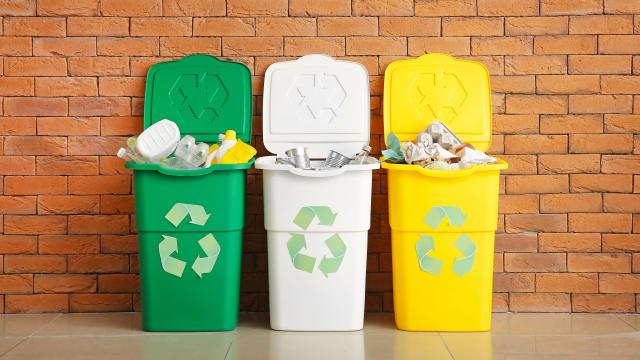We all know that, in theory, we should be recycling — but there are a lot of myths and misconceptions that can make it difficult to know what, exactly, should be recycled — and how. To avoid recycling the wrong thing (which can contaminate other, perfectly good recyclables in your bin) and not recycling the right thing, let’s bust a few of those myths. We called in Jeremy Walters, the sustainability ambassador for Republic Services, to walk us through it.
When in doubt, throw it out
The most important thing you can do when recycling is to be realistic and educated. Walters says most people have the best intentions, so they recycle whatever they think they can, which he calls “wish-cycling.” Best intentions aren’t good enough, though, as they can result in you recycling the wrong thing. Not only can you contaminate other recyclables, but you could damage equipment at the recycling facility or even harm employees.
To that end, your mantra should be: “When in doubt, throw it out.” Don’t feel like a failure if you still turn to the regular old trash can regularly; it’s better to be safe than sorry. Walters suggests focusing on recycling cardboard, paper, aluminium cans, and plastic bottles or jugs to make the most impact.
How to prepare recyclables correctly
Walters adds that “empty, clean, and dry” and the “magic words of recycling.” Even if you’re recycling the right things, it’s still no good if they have residual food or liquid on them. Rinse and dry everything to make sure no residue gets on your other recyclables.
This brings us to a very specific example: Although cardboard is almost always a win for recycling, it’s not an easy slam dunk every time. Pizza boxes are particularly tricky. The cardboard itself would be perfect for recycling — if it weren’t all greasy. Only recycle cardboard, plastic, etc., if you can truly remove all the residue from it.
No bagging
Yes, you can use a plastic or paper bags to collect the recyclables in your home, but in most locations, you shouldn’t keep them bagged when you toss them out.
“Materials must stay loose so they can easily be sorted and separated at the recycling centre,” says Walters, who suggests collecting your recyclables in a basket in your home so you can just dump it into your curbside cart when the time comes.
There are exceptions to this, though. For example, in New York City, you can use clear plastic bags, but you have to separate paper from everything else. You should always check your own local guidelines for nuances like these.
Don’t confuse reuse and recycle
Finally, circling back to those good intentions, Walter says it’s common for people to confuse the idea of “recycling” with that of “reusing.” It’s great for sustainability overall if you reuse or donate an old item, but that doesn’t mean that item can be recycled.
Walters used the example of someone who used to enjoy bowling, gave it up, and put the ball and shoes in the recycling bin, which actually happens a lot more often than you’d think. It’s better to keep a bin for donation items in your home alongside the recyclables and not attempt to recycle everything just because you’re finished using it.

Leave a Reply
You must be logged in to post a comment.